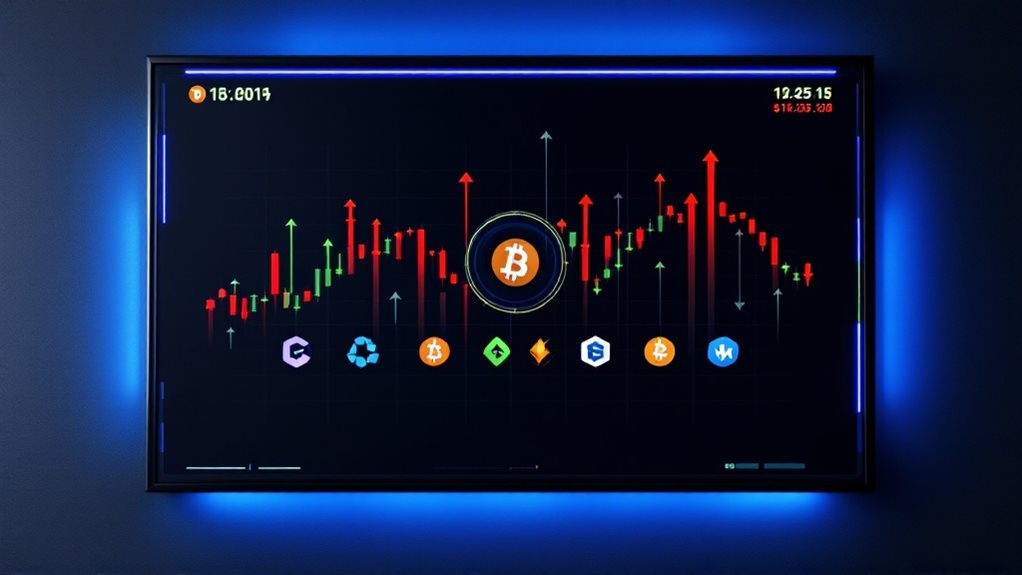ETF stands for Exchange-Traded Fund. It’s a popular investment that combines features of both stocks and mutual funds. ETFs hold a variety of investments like stocks, bonds, or commodities in one tradable package. They trade on stock exchanges just like regular stocks and can be bought or sold throughout the trading day. While ETFs offer diversification through a single security, understanding their different types and characteristics reveals their full potential.
Quick Overview
- ETF stands for Exchange-Traded Fund, a popular investment vehicle that combines features of both stocks and mutual funds.
- ETFs are securities that trade on stock exchanges throughout the day, just like individual stocks.
- These funds hold a basket of underlying assets, such as stocks, bonds, or commodities, tracking specific market indices.
- The first ETF in the United States was the SPDR S&P 500 ETF, setting the foundation for this investment type.
- ETFs offer investors a way to achieve instant diversification through a single, easily tradable security.

ETF stands for Exchange-Traded Fund, a popular investment product that trades on stock exchanges like regular stocks. ETFs combine features of both stocks and mutual funds, making them a unique investment option. They work by holding a basket of securities that typically track an underlying index, providing investors with diversification through a single tradable security.
One of the key features of ETFs is their trading flexibility. Unlike mutual funds that trade once per day after the market closes, ETFs can be bought and sold throughout the trading day at market prices. They’re known for their high liquidity, which means investors can easily convert them to cash when needed. Market makers help maintain this liquidity by facilitating trades between buyers and sellers. Authorized participants create and redeem ETF units by exchanging underlying assets with fund managers.
ETFs also tend to have lower expense ratios compared to traditional mutual funds, making them a cost-effective choice for many investors. The first ETF in the United States was the SPDR S&P 500 ETF, launched to track the S&P 500 Index.
There are several different types of ETFs available in the market. Index ETFs track specific market indices, like the S&P 500. Sector ETFs focus on particular industries, such as technology or healthcare. Bond ETFs give investors exposure to the fixed-income market, while commodity ETFs track the prices of raw materials like gold or oil.
There are also actively managed ETFs where portfolio managers try to beat market benchmarks.
ETFs offer a high level of transparency, as their holdings are typically disclosed daily. This transparency allows investors to know exactly what they own at any given time. They’re also known for their tax efficiency because they generally have lower portfolio turnover compared to actively managed mutual funds. This lower turnover often results in fewer taxable events for investors.
To invest in ETFs, investors need a brokerage account, as these funds trade on exchanges just like stocks. While ETFs can help reduce single-stock risk through diversification, it’s essential to recognize that they still carry investment risks. Each type of ETF has its own risk profile based on its underlying assets and investment strategy.
The investment world has embraced ETFs due to their numerous advantages. They’ve become increasingly popular among both individual and institutional investors because they offer a simple way to access different markets and asset classes.
Their structure combines the diversification benefits of mutual funds with the trading convenience of stocks, making them an important tool in modern investing. As the ETF market continues to grow, investors have access to an ever-expanding range of investment options through these versatile securities.
Frequently Asked Questions
How Do ETFS Compare to Mutual Funds in Terms of Fees?
ETFs typically cost less than mutual funds.
While mutual funds often charge between 0.5% to 2% in fees, ETFs usually charge between 0.05% to 0.75%.
On average, index ETFs charge 0.16%, while actively managed mutual funds charge 0.66%.
ETFs have a simpler fee structure with just one main fee, while mutual funds might have extra costs like operational fees.
ETFs don’t charge load fees, but some mutual funds do.
Can I Trade ETFS Through Any Brokerage Account?
Most brokerage accounts allow ETF trading these days.
Investors can buy and sell ETFs through traditional brokers, online platforms, and mobile trading apps. Many major brokers offer commission-free ETF trades, making them widely accessible.
ETFs can be traded in various account types, including individual brokerage accounts, retirement accounts like IRAs, and some 401(k) plans.
Some brokers even offer fractional ETF shares, letting people invest with smaller amounts.
What Happens if an ETF Company Goes Bankrupt?
If an ETF company goes bankrupt, investors’ money stays safe because ETFs are set up as separate legal entities from the provider company.
The actual ETF assets aren’t owned by the provider – they’re held by independent custodians.
During bankruptcy, the ETF would likely go through an orderly closure process. Shareholders would receive their portion of the fund’s value, either by selling their shares or waiting for the final liquidation payout.
Are ETFS Suitable for Short-Term Trading Strategies?
ETFs can work well for short-term trading because they’re easy to buy and sell during market hours, just like stocks.
They typically have low trading costs and good liquidity, meaning traders can move in and out of positions quickly.
Many ETFs track different market sectors, allowing traders to take advantage of short-term market movements.
However, like any investment, short-term ETF trading comes with risks of losing money.
Do All ETFS Pay Dividends to Investors?
Not all ETFs pay dividends to investors. It depends on what the ETF holds.
ETFs that contain dividend-paying stocks usually pass those dividends on to investors. Bond ETFs typically make regular interest payments. Some ETFs choose to reinvest dividends instead of paying them out.
Real estate ETFs often offer dividend payments, while commodity ETFs generally don’t. Each ETF’s dividend policy is outlined in its prospectus.





